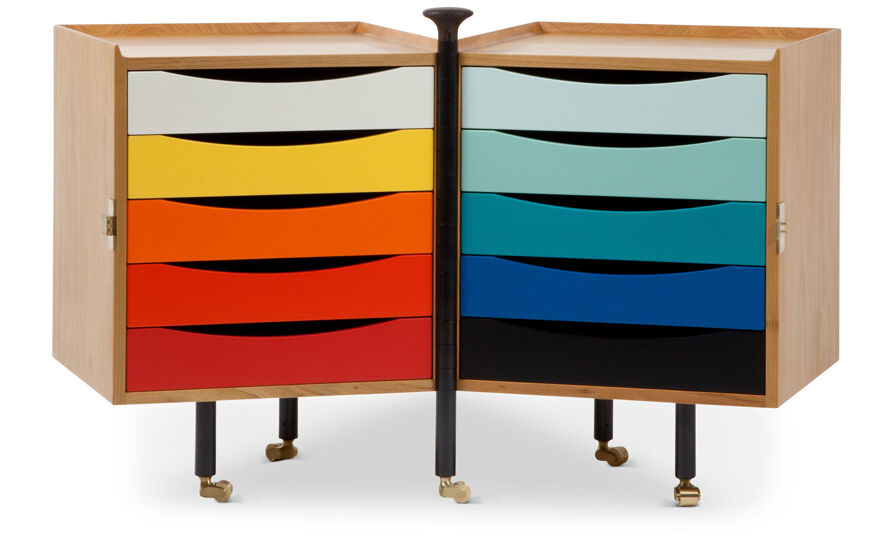Glove Cabinet
by Finn Juhl from house of finn juhl
glove cabinet
Design Finn Juhl, 1961
Solid Japanese cherry wood, wengé, burnished steel, brass
Made in Denmark by House of Finn Juhl
The Glove Cabinet, designed by Finn Juhl for his wife Hanne Wilhelm Hansen, was presented by Ludwig Pontoppidan at the Cabinetmakers' Guild Exhibition in 1961 as part of a collection of bedroom furniture. The exhibition in 1961, where Finn Juhl presented the Glove Cabinet, marked Finn Juhl's 25th anniversary and became his last exhibition of that kind. The exclusive cabinet opens up like a jewelry box and reveals a daring and colorful interior.
Finn Juhl's designs indeed possess longevity. With his artistic approach to design, Finn Juhl was one of the few who mastered both functionality and delicate details. The Glove Cabinet was originally designed by Finn Juhl for his wife, Hanne Wilhelm Hansen as an elegant storage for her glove collection. Although women no longer wear gloves like in the 1960s, Finn Juhl's reinvention of the traditional chest of drawers still stands the test of time more than 60 years later. Today the Glove Cabinet is an extraordinary tribute to both the past, present and the future. The delicate Glove Cabinet can also be spotted in Finn Juhl's own house in Ordrup north of Copenhagen.
The experimental 1961 exhibition became the focal point of strong criticism, especially from designers such as Børge Mogensen and Arne Karlsen, who were followers of the Klint School of furniture design. Their view was based on a social aesthetic functionalism, where unnecessary decoration was frowned upon. Finn Juhl took a humoristic stance when he responded to the criticism: "But why should we take the joy out of everything? It is completely wrong of these two stern critics to warn the young against using their imagination - and pointless too, by the way, for they will probably do so, no matter what" he rebutted. Curiosity and inventiveness are defining characteristics of Finn Juhl's work both as an architect and a furniture designer. This became especially apparent at the 1961 exhibition.
The Glove Cabinet is made from exclusive Japanese cherry wood, with drawers painted in Finn Juhl's warm and cold range of colors. The cabinet is supported by burnished steel legs finished with wheels and brass fittings.
27.25" w | 13.7" d | 20.4" h
Solid Japanese cherry wood, wengé, burnished steel, brass
Made in Denmark by House of Finn Juhl
The Glove Cabinet, designed by Finn Juhl for his wife Hanne Wilhelm Hansen, was presented by Ludwig Pontoppidan at the Cabinetmakers' Guild Exhibition in 1961 as part of a collection of bedroom furniture. The exhibition in 1961, where Finn Juhl presented the Glove Cabinet, marked Finn Juhl's 25th anniversary and became his last exhibition of that kind. The exclusive cabinet opens up like a jewelry box and reveals a daring and colorful interior.
Finn Juhl's designs indeed possess longevity. With his artistic approach to design, Finn Juhl was one of the few who mastered both functionality and delicate details. The Glove Cabinet was originally designed by Finn Juhl for his wife, Hanne Wilhelm Hansen as an elegant storage for her glove collection. Although women no longer wear gloves like in the 1960s, Finn Juhl's reinvention of the traditional chest of drawers still stands the test of time more than 60 years later. Today the Glove Cabinet is an extraordinary tribute to both the past, present and the future. The delicate Glove Cabinet can also be spotted in Finn Juhl's own house in Ordrup north of Copenhagen.
The experimental 1961 exhibition became the focal point of strong criticism, especially from designers such as Børge Mogensen and Arne Karlsen, who were followers of the Klint School of furniture design. Their view was based on a social aesthetic functionalism, where unnecessary decoration was frowned upon. Finn Juhl took a humoristic stance when he responded to the criticism: "But why should we take the joy out of everything? It is completely wrong of these two stern critics to warn the young against using their imagination - and pointless too, by the way, for they will probably do so, no matter what" he rebutted. Curiosity and inventiveness are defining characteristics of Finn Juhl's work both as an architect and a furniture designer. This became especially apparent at the 1961 exhibition.
The Glove Cabinet is made from exclusive Japanese cherry wood, with drawers painted in Finn Juhl's warm and cold range of colors. The cabinet is supported by burnished steel legs finished with wheels and brass fittings.
27.25" w | 13.7" d | 20.4" h
Finn Juhl
Finn Juhl aimed at a more organic and natural design form without role models or inherited restrictions. He designed by measuring his own body and analyzing how the individual components of the chair should carry the human body.
Finn Juhl’s design universe is a joyful journey of shapes, aesthetics and inspiration. These classic Danish Modern masterpieces are authorized, licensed & manufactured in Denmark with respect for heritage and quality.
















 write a review now
write a review now
